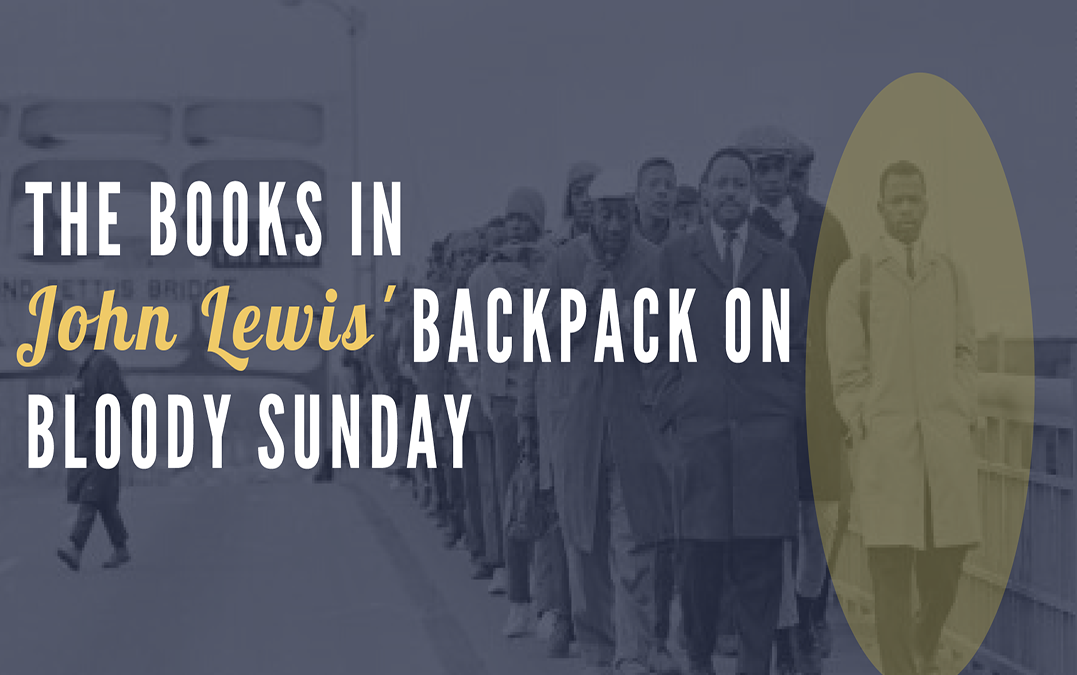
Leadership
On Bloody Sunday, John Lewis wore a backpack. It carried fruit, a toothbrush, and two books. Lewis had expected to spend the night reading in jail. Instead, he spent it in the hospital after his skull was fractured from a police beating. He would carry the scars from that beating at age 25 for the rest of his life. He’d also carry out the rest of his life guided by the principles in the two books in his backpack that Sunday, March 7, 1965.
One book was The American Political Tradition, a reappraisal of this history of the United States written by Richard Hofstadter in 1948. The other book, also first published in 1948, was The Seven Storey Mountain, the autobiography of Catholic monk Thomas Merton and his journey to a life in Christ. It was Christ’s instruction to love thy neighbor that drew Lewis to Martin Luther King’s nonviolent message which they used to speak up against racial injustice in America.
How does a young man find the courage to sit before open hatred at lunch counters, and face police lines protected only by an ideal? In a word – love. The monk, Thomas Merton wrote,
Our job is to love others without stopping to inquire whether or not they are worthy. That is not our business and, in fact, it is nobody’s business. What we are asked to do is to love, and this love itself will render both ourselves and our neighbors worthy.
John Lewis left a legacy of love. Not a pollyannaish love, but a durable, tempered conviction that a belief in common humanity and the pursuit of equality will win in the end. “If we get it right here, in America, maybe, just maybe we can be the model for the rest of the world,” Lewis often said.
It’s hard not to judge others in this year triple underscored by racial, social, and political division. But doing so is what makes love so powerful. It’s value increased every time leaders like John Lewis endured physical blows and sacrifice in the name of equality. Lewis believed that America was worth the pain and sacrifice.
Lewis’ love filled him with irrepressible happiness despite all that he’d been through. His life is a monument to love. Now that his journey is over, his life is testimony to the power of love that speaks to us all. The political book in that backpack starts with a quote from the writer John Dos Passos:
In times of change and danger when there is a quicksand of fear under man’s reasoning, a sense of continuity with generations gone before can stretch like a lifeline across the scary present.
John Robert Lewis was that lifeline. His body will be put to rest, but his legacy of showing up, speaking out, and moving forward until, as Lewis said, “the revolution of 1776 is complete,” must carry on.
“If not us, then who? If not now, then when?” – John Lewis
Question: How can you use your platform to complete the revolution of 1776?
We have important work ahead of us as we stand up to racism, bias and inequity. Read an open letter our CEO wrote on our company’s commitment to shed light and work for justice.
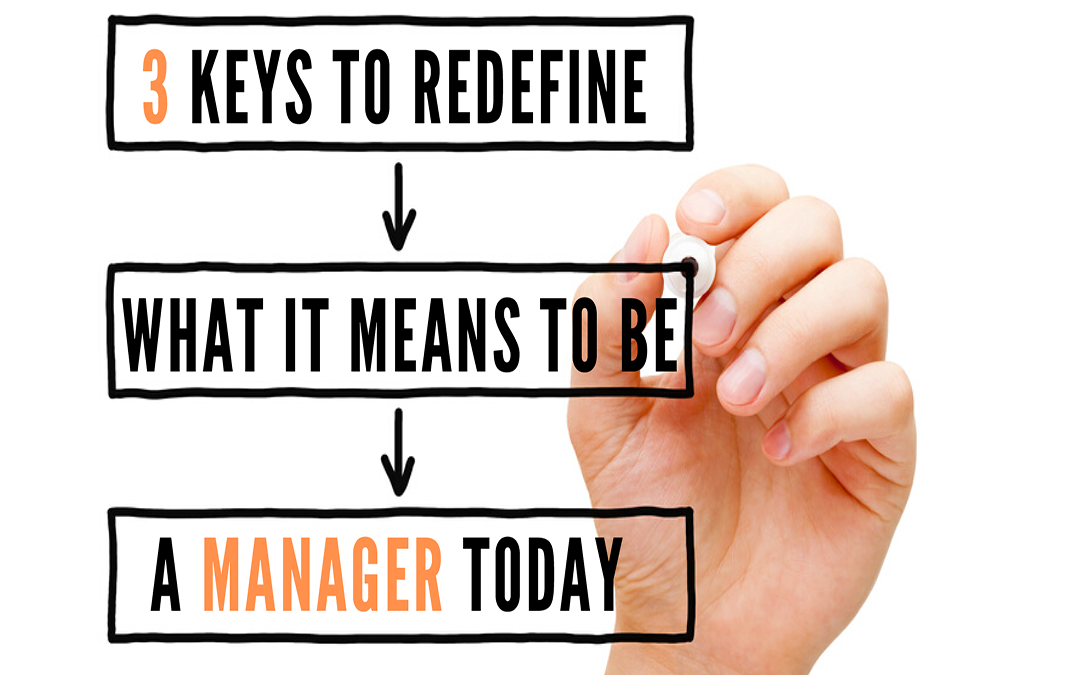
Leadership
A study by Harvard Business School found that more than half of a manager’s time is spent on administrative tasks and only 7% of their time (about 2.8 hours per week) is spent on developing people and engaging with stakeholders. After engaging stakeholders, developing people is likely closer to 1 hour per week. This chronic lack of time spent on employee development is equivalent to the phenomenon known as ghosting which perpetuates both the quit rate and burnout rate. To break this cycle, the role and purpose of today’s managers must change in three fundamental ways:
From controlling to coaching. While the world’s workplaces have been going through extraordinary historical change, the practice of management has been stuck in time for more than 30 years. The new workforce — especially younger generations — wants their work to have deep mission and purpose, and they don’t want old-style command-and-control bosses. They want coaches who inspire them, communicate with them frequently and develop their strengths.
From deciding to delegating. Too many managers don’t let direct reports make decisions for fear that mistakes will take too much valuable time to correct. This tendency restricts employees’ ability to develop their thinking and decision making which is exactly what is needed to help organizations remain competitive. Today’s managers don’t need to be the smartest person in the room. They need to tap into the collective intelligence and draw out everyone’s best thinking.
From ‘what works’ to ‘what if’. Managers often encourage predictability. They want processes in place that can be referred to regardless of who is in the role. The problem with this management style is that it leads to perpetuating the status quo at the expense of what is possible. Today’s managers don’t need hired hands to turn raw materials into products. They need hearts and minds that are challenged to find better ways to operate, to discover ways to grow, and to reimagine how things have been done in the past.
Today’s managers play a critical role in helping your organization adapt to the new workplace demands. Help them succeed by reimagining them as coaches who encourage critical thinking and curiosity.
Question: Do your managers spend more time reporting to senior leaders or coaching emerging ones?
Driven by the premise that excellence is the result of aligning people, purpose and performance, Center for Executive Excellence facilitates training in leading self, leading teams and leading organizations. To learn more, subscribe to receive CEE News!
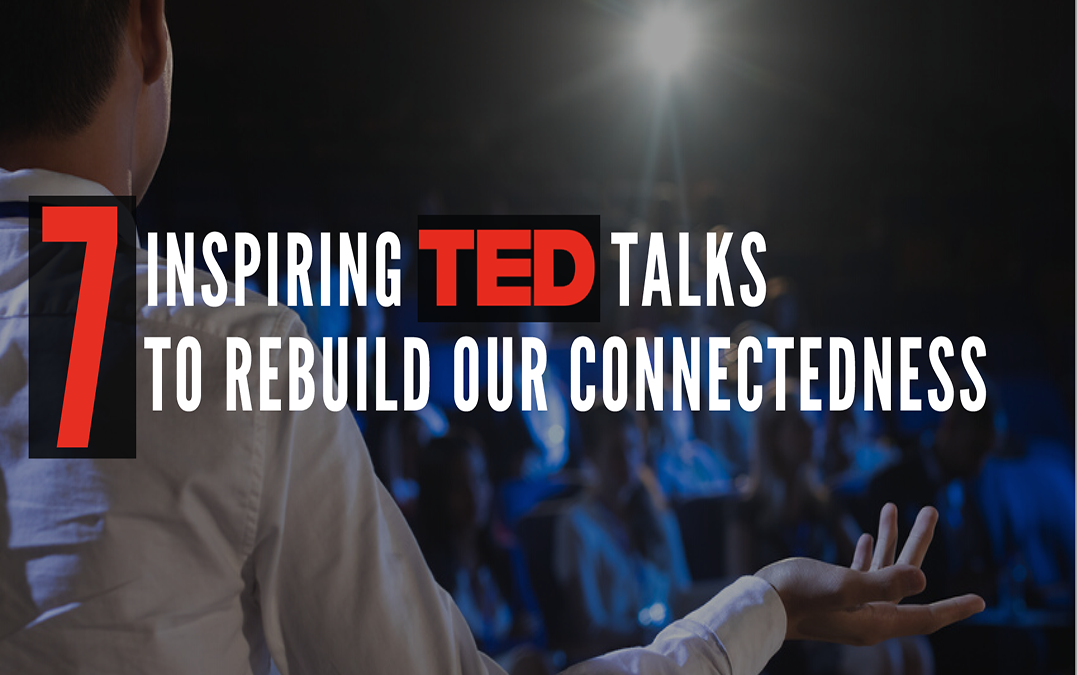
Leadership
The first six months of 2020 was a stress test on every system, structure, and social norm known to humanity.
The fear of a raging pandemic, combined with being trapped indoors or braving the disease as an essential worker for months tested our ability to deal with anxiety. Every person experienced loss – of a loved one, a job, or the ability to gather for weddings, funerals, birthdays, holidays, and graduations. Every person fought to keep their mental health in check while dealing with relentless bad news and unreliable leadership.
Our society is going through a hard reboot. We don’t know how long this reboot will last, but we have a choice about what it will yield, and whether we will let fear or hope shape our collective outcome. If we give in to fear, we’ll continue to let our behavior be dictated by our amygdala, the evolutionary part of our brains responsible for fight or flight in the face of danger. We’ll operate as though we’re in a war zone, and instantly assess whether every person, interaction, and social media post is a threat.
If we have hope that our better nature will prevail, we’ll have to override the steady diet of negativity that our amygdala feed on and rewire our neural networks in a process known as neuroplasticity. We’ll have to stop seeing our differences as a threat, and start rebuilding our curiosity and compassion. Sometimes it’s easy to think the worst of human beings and focus on the negative. But these inspiring TED talks can help us put down our shields, rebuild our connectedness, and have the courage to share our vulnerability.
 1. Depression, the secret we share by Andrew Solomon
1. Depression, the secret we share by Andrew Solomon
About the Talk: “The opposite of depression is not happiness, but vitality, and it was vitality that seemed to seep away from me in that moment.” In a talk equal parts eloquent and devastating, writer Andrew Solomon takes you to the darkest corners of his mind during the years he battled depression. That led him to an eye-opening journey across the world to interview others with depression — only to discover that, to his surprise, the more he talked, the more people wanted to tell their own stories.
About the Speaker: Andrew Solomon, Ph.D., is a writer and lecturer on politics, culture and psychology; winner of the National Book Award; and an activist in LGBTQ rights, mental health, and the arts. He is Professor of Clinical Medical Psychology (in Psychiatry) at Columbia University Medical Center, and a former President of PEN American Center.
 2. We don’t “move on” from grief. We move forward with it. by Nora McInerny
2. We don’t “move on” from grief. We move forward with it. by Nora McInerny
About the Talk: In a talk that’s by turns heartbreaking and hilarious, writer and podcaster Nora McInerny shares her hard-earned wisdom about life and death. Her candid approach to something that will, let’s face it, affect us all, is as liberating as it is gut-wrenching. Most powerfully, she encourages us to shift how we approach grief. “A grieving person is going to laugh again and smile again,” she says. “They’re going to move forward. But that doesn’t mean that they’ve moved on.”
About the Speaker: Nora McInerny is an American author. She writes about dealing with grief and loss, drawing on her personal experience of miscarrying a child and losing both her father and husband to cancer within several weeks in 2014.
 3. Embracing the shake by Phil Hansen
3. Embracing the shake by Phil Hansen
About the Talk: In art school, Phil Hansen developed an unruly tremor in his hand that kept him from creating the pointillist drawings he loved. Hansen was devastated, floating without a sense of purpose. Until a neurologist made a simple suggestion: embrace this limitation … and transcend it.
About the Speaker: Taking a cue from his own artistic journey, Phil Hansen challenges us to spark our creativity by thinking inside the box.
 4. An interview with the Queen of Creole Cuisine with Leah Chase and Pat Mitchell
4. An interview with the Queen of Creole Cuisine with Leah Chase and Pat Mitchell
About the Talk: Leah Chase’s New Orleans restaurant Dooky Chase changed the course of American history over gumbo and fried chicken. During the civil rights movement, it was a place where white and black people came together, where activists planned protests and where the police entered but did not disturb. In conversation with TEDWomen Curator Pat Mitchell, the 94-year old Queen of Creole Cuisine shared her wisdom from a lifetime of activism, speaking up and cooking.
About the Speaker: Leah Chase spent seven decades serving her signature gumbo and hospitality to everyone from Martin Luther King, Jr. to James Baldwin to Barack Obama.
 5. The other side of ego by Jonathan Gravenor
5. The other side of ego by Jonathan Gravenor
About the Talk: As he stared at the end of his life when diagnosed with cancer, Jonathan was hit with the fact he had become the kind of man he would not want to be near. Two remarkable people appeared and taught him life’s greatest lessons. That started him on the road to redemption that saved his soul.
About the Speaker: From war zones to Olympic games, from red carpets to national elections, if it was a big story, Jonathan Gravenor was there. For over two decades he was a foreign correspondent, a broadcast journalist, and presenter delivering the news to millions of people. In the world of journalism he had it all, that is until that all included cancer. Suddenly faced with the possibility of impending death, he was forced to look at who he was and what his legacy would be.
 6. I got 99 problems . . . palsy is just one of them by Maysoon Zayid
6. I got 99 problems . . . palsy is just one of them by Maysoon Zayid
About the Talk: “I have cerebral palsy. I shake all the time,” Maysoon Zayid announces at the beginning of this exhilarating, hilarious talk. “I’m like Shakira meets Muhammad Ali.” With grace and wit, the Arab-American comedian takes us on a tour of her adventures as an actress, stand-up comic, philanthropist and advocate for the disabled.
About the Speaker: Maysoon Zayid is an American actress and comedian. Of Palestinian descent, she is known as one of America’s first Muslim women comedians and the first person ever to perform stand-up in Palestine and Jordan.
 7. Abundance is our future by Peter Diamandis
7. Abundance is our future by Peter Diamandis
About the Talk: On stage at TED2012, Peter Diamandis makes a case for optimism — that we’ll invent, innovate and create ways to solve the challenges that loom over us. “I’m not saying we don’t have our set of problems; we surely do. But ultimately, we knock them down.”
About the Speaker: Peter Diamandis runs the X Prize Foundation, which offers large cash incentive prizes to inventors who can solve grand challenges like space flight, low-cost mobile medical diagnostics and oil spill cleanup. He is the chair of Singularity University, which teaches executives and grad students about exponentially growing technologies.
Question: What are you doing to stop seeing differences as a threat?
Driven by the premise that excellence is the result of aligning people, purpose and performance, Center for Executive Excellence facilitates training in leading self, leading teams and leading organizations. To learn more, subscribe to receive CEE News!
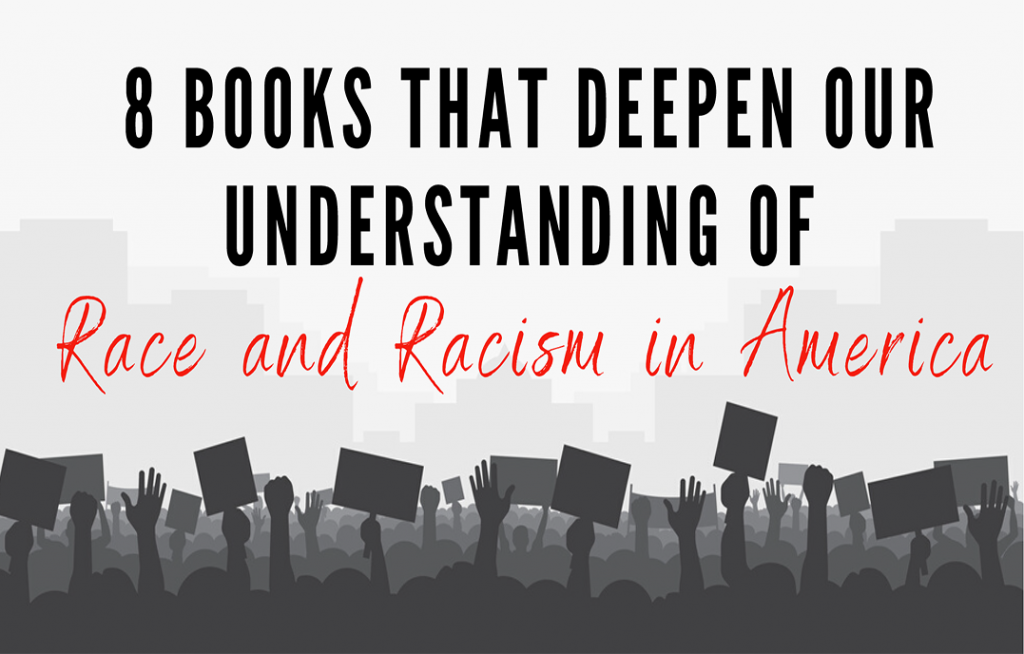
Leadership, Uncategorized
This year has given Americans the opportunity to face some ugly truths about our country. The torch that was lit when George Floyd was murdered on Memorial Day continues to burn day and night. Under that light, American citizens are daring to step out of the protection of their houses and step into the public square to debate issues such as freedom, patriotism, policing, and racism. Young adults are leading the charge in the streets and on social media to raise awareness that we can no longer neglect the past or remain willfully ignorant of the severity and scope of our country’s racial disparity. Yet, many of us lack the words to articulate our current turmoil or find the path forward.
In an effort to deepen our understanding of race and racism in America, we’re turning to authors to shed light on how we got to where we are, how to have civil discourse about inflammatory topics, and steps that we can take individually and collectively to heal. Here are eight books written by academics, historians and activists that we are reading.
 1. The People’s History of the United States by Howard Zinn
1. The People’s History of the United States by Howard Zinn
What it’s about: This classic national bestseller chronicles American history from the bottom up, throwing out the official narrative taught in schools—with its emphasis on great men in high places—to focus on the street, the home, and the workplace.
Why pick it up: Zinn shows that many of America’s greatest battles – fights for fair wages, eight-hour workdays, child labor laws, health and safety standards, universal suffrage, women’s rights, racial equality – were carried out at the grassroots level, against bloody resistance.
 2. The Racial Contract by Charles W. Mills
2. The Racial Contract by Charles W. Mills
What it’s about: With a sweeping look at the European expansionism and racism of the last five hundred years, Charles W. Mills demonstrates how this peculiar and unacknowledged “contract” has shaped a system of global European domination: how it brings into existence “whites” and “non-whites,” full persons and sub-persons, how it influences white moral theory and moral psychology; and how this system is imposed on non-whites through ideological conditioning and violence.
Why pick it up: “Fish don’t see water, men don’t see patriarchy, and white philosophers don’t see white supremacy. We can do little about fish. Now Charles Mills has made it clear how whites dominate people of color, even (or especially) when they have no such intention. He asks whites not to feel guilty, but rather to do something much more difficult – understand and take responsibility for a structure which they did not create but still benefit from.” – Jennifer Hochschild, Princeton University
 3. The New Jim Crow: Mass Incarceration in the Age of Colorblindness by Michelle Alexander
3. The New Jim Crow: Mass Incarceration in the Age of Colorblindness by Michelle Alexander
What it’s about: In 2008, months before his election as president, Barack Obama assailed feckless black fathers who had reneged on responsibilities that ought not “to end at conception”. Where had all the black fathers gone, Obama wondered. In The New Jim Crow, Michelle Alexander has a simple answer to their whereabouts: they’ve gone to jail. Alexander’s book is a stunning account of the rebirth of a caste-like system in the United States, one that has resulted in millions of African Americans locked behind bars and then relegated to a permanent second-class status – denied the very rights supposedly won in the Civil Rights Movement. Since its publication in 2010, the book became a New York Times bestseller; been dubbed the “secular bible of a new social movement” by numerous commentators, including Cornel West; and has led to consciousness-raising efforts in universities, churches, community centers, re-entry centers, and prisons nationwide. The New Jim Crow tells a truth our nation has been reluctant to face.
Why pick it up: Alexander shows that, by targeting black men through the War on Drugs and decimating communities of color, the U.S. criminal justice system functions as a contemporary system of racial control, even as it formally adheres to the principle of colorblindness. The New Jim Crow challenges the civil rights community – and all of us – to place mass incarceration at the forefront of a new movement for racial justice in America.
 4. White American Youth: My Dissent Into America’s Most Violent Hate Movement – And How I Got Out by Christian Picciolini
4. White American Youth: My Dissent Into America’s Most Violent Hate Movement – And How I Got Out by Christian Picciolini
What it’s about: At 14, Christian Picciolini went from naïve teenager to white supremacist – and soon, the leader of the first neo-Nazi skinhead gang in the United States. How was he radicalized, and how did he ultimately get out of the movement? In this courageous book, Picciolini shares the surprising and counterintuitive solution to hate in all forms.
Why pick it up: As featured on the TED stage, a stunning look inside the world of violent hate groups by a onetime white supremacist leader who, shaken by a personal tragedy, abandoned his destructive life to become an anti-hate activist.
 5. Rising Out of Hatred: The Awakening of a Former White Nationalist by Eli Saslow
5. Rising Out of Hatred: The Awakening of a Former White Nationalist by Eli Saslow
What it’s about: Derek Black grew up at the epicenter of white nationalism. His father founded Stormfront, the largest racist community on the internet. His godfather, David Duke, was a KKK Grand Wizard. By the time Derek turned 19, he had become an elected politician with his own daily radio show – already regarded as the “the leading light” of the burgeoning white nationalist movement.
Then he went to college. At New College of Florida, he continued to broadcast his radio show in secret each morning, living a double life until a classmate uncovered his identity and sent an email to the entire school. “Derek Black … white supremacist, radio host … New College student???” The ensuing uproar overtook one of the most liberal colleges in the country. Some students protested Derek’s presence on campus, forcing him to reconcile for the first time with the ugliness of his beliefs. Other students found the courage to reach out to him, including an Orthodox Jew who invited Derek to attend weekly Shabbat dinners. It was because of those dinners – and the wide-ranging relationships formed at that table – that Derek started to question the science, history, and prejudices behind his worldview. As white nationalism infiltrated the political mainstream, Derek decided to confront the damage he had done.
Why pick it up: “No one can match Pulitzer Prize winner Eli Saslow’s skill at telling the most improbable, humane, and riveting tales of our time. Anyone despairing at the hate that has fueled so much of America’s politics ought to read this unforgettable story.” – Jane Mayer, New York Times bestselling author.
 6. Between the World and Me by Ta-Nehisi Coates
6. Between the World and Me by Ta-Nehisi Coates
What it’s about: What is it like to inhabit a black body and find a way to live within it? And how can we all honestly reckon with this fraught history and free ourselves from its burden? Between the World and Me is Ta-Nehisi Coates’s attempt to answer these questions in a letter to his adolescent son. Coates shares with his son – and readers – the story of his awakening to the truth about his place in the world through a series of revelatory experiences, from Howard University to Civil War battlefields, from the South Side of Chicago to Paris, from his childhood home to the living rooms of mothers whose children’s lives were taken as American plunder.
Why pick it up: Beautifully woven from personal narrative, reimagined history, and fresh, emotionally charged reportage, Between the World and Me clearly illuminates the past, bracingly confronts our present, and offers a transcendent vision for a way forward.
 7. White Fragility: Why It’s So Hard for White People to Talk About Racism by Robin Diangelo
7. White Fragility: Why It’s So Hard for White People to Talk About Racism by Robin Diangelo
What it’s about: The New York Times best-selling book exploring the counterproductive reactions white people have when their assumptions about race are challenged, and how these reactions maintain racial inequality. Robin DiAngelo, a white woman and antiracist educator, deftly illuminates the phenomenon of white fragility and “allows us to understand racism as a practice not restricted to ‘bad people’. Referring to the defensive moves that white people make when challenged racially, white fragility is characterized by emotions such as anger, fear, and guilt, and by behaviors including argumentation and silence. These behaviors, in turn, function to reinstate white racial equilibrium and prevent any meaningful cross-racial dialogue.
Why pick it up: DiAngelo invites us to have courageous conversations about the culture of complicity. To eradicate racism, she encourages white people to relinquish ingrained hyper-attachment to individualism and embrace predictable patterns of their own racial group. Her book provides strategies for people who truly endeavor to be a part of the solution.
 8. So You Want to Talk About Race by Ijeoma Oluo
8. So You Want to Talk About Race by Ijeoma Oluo
What it’s about: How do you tell your roommate her jokes are racist? Why did your sister-in-law take umbrage when you asked to touch her hair – and how do you make it right? How do you explain white privilege to your white, privileged friend? In So You Want to Talk About Race, Ijeoma Oluo guides readers of all races through subjects ranging from intersectionality and affirmative action to “model minorities” in an attempt to make the seemingly impossible possible: honest conversations about race and racism, and how they infect almost every aspect of American life.
Why pick it up: Whether you’re beginning your journey to understanding racism in America or believe yourself to be well-versed on the subject, this book is a tool to help broach conversations and help us work toward a better world for people of color from all walks of life.
Question: What books are you reading to understand and dismantle racism?
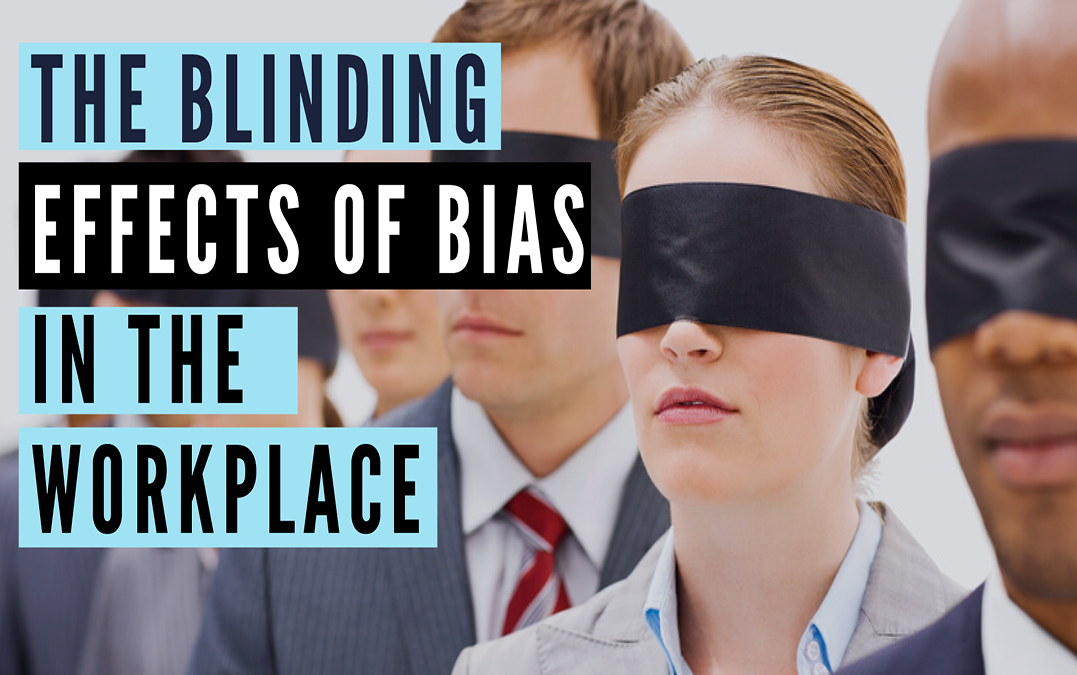
Leadership
A little girl named Jennifer grew up in Cleveland in the 1970’s. At age twelve, her family moved out of the city which meant Jennifer had to change schools. Like most 12-year olds, she was anxious about making a good impression on her new schoolmates and hoped to make friends quickly. Fortunately, Jennifer’s new classmates went out of their way to welcome her. Unfortunately, however, Jennifer struggled. She couldn’t remember who was who. She’d pass classmates in the hall without speaking. She’d call students by the wrong name. She couldn’t remember names of the people she’d sat next to just the day before during lunch.
We’ve all been the new kid at one time or another. It’s not easy to match faces with names while taking in the newness of it all. But, for most of us, we start to add people to our memory bank within a few days or a few weeks at most. Not so for Jennifer. For an entire school year, she was at a loss. For the first time in her life, she was stripped of the most basic skill of separating the faces of other people. But, why? That’s the question that Jennifer dedicated her life to answering.
Today, Dr. Jennifer Eberhardt is a professor and researcher at Stanford University. In her recent book, Biased: Uncovering the Hidden Prejudice That Shapes What We See, Think, and Do, she writes, “I’d struggled to recognize my white classmates’ faces because black faces were all I’d been routinely exposed to in the twelve years before I moved to the suburbs.” By the time she changed schools as an adolescent, Jennifer’s brain had been shaped by her exposure to people who looked like her. Learning to distinguish the facial features of people who were not black was simply not necessary to navigate life in her Cleveland neighborhood. As Eberhardt writes, “We reserve our precious cognitive resources for those who are ‘like us.’” Otherwise, she explains, “we see categories.”
Categorization, it turns out, is a natural function of the brain that allows us to organize and manage the overload of stimuli. It helps us quickly sort safety from danger by relying on patterns that seem predictable. As Jennifer Eberhardt’s story illustrates, categorization is natural. In the workplace, however, categorization can lead to stereotyping, or holding positive or negative beliefs about social groups. Taken further, stereotyping can lead to bias, or acting on the beliefs we hold about social groups.
In the context of the workplace, bias is bad for business. Not only are members of the workforce excluded from opportunities to make an impact, but research shows that teams that lack diversity are more susceptible to making flawed decisions.

As the graphics above illustrate, homogeneous teams and diverse teams were given the same problems to solve. The diverse teams achieved a significantly higher rate of accuracy, yet the homogenous teams had a higher rate of perceived effectiveness and higher confidence in their decisions. The homogeneous teams were less likely to challenge one another’s perspective, while the diverse teams tended to examine facts and remain objective.
Entrenched thinking can blind us to key information and lead to errors in the decision-making processes. Though it may seem easier to work with people who share our background, working on diverse teams produces better outcomes precisely because it helps us pause to question our assumptions.
Question: When was the last time you caught yourself being biased?
Driven by the premise that excellence is the result of aligning people, purpose and performance, Center for Executive Excellence facilitates training in leading self, leading teams and leading organizations. To learn more, subscribe to receive CEE News!
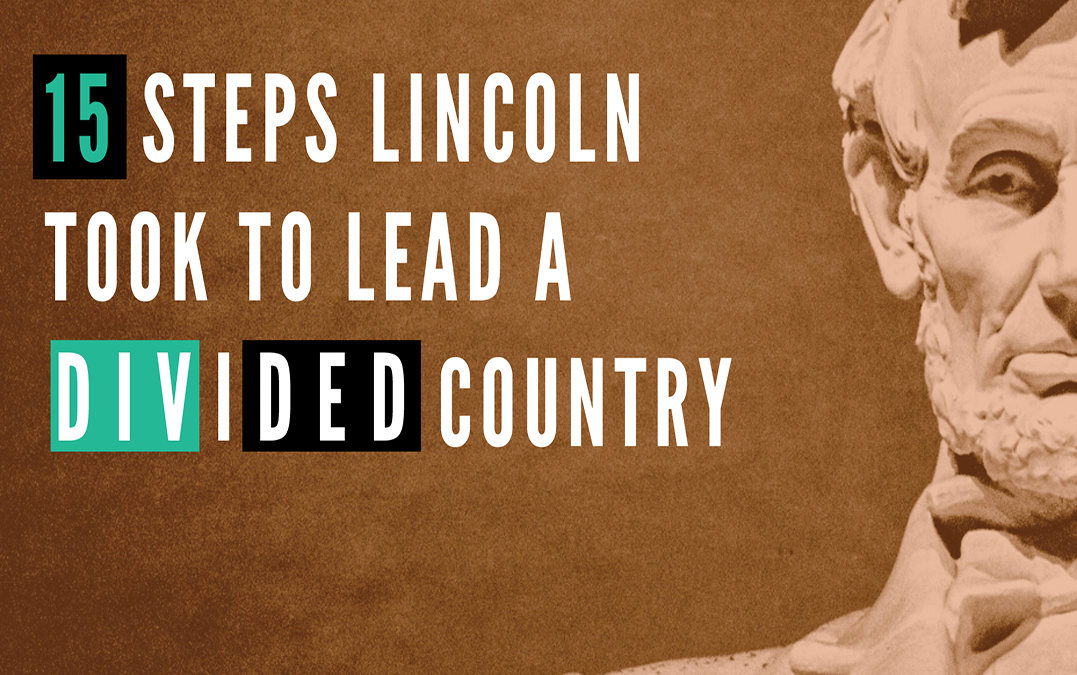
Leadership
It’s been just over two weeks since George Floyd called out for his mother as his life was callously drained away by a white police officer in broad daylight on a Minneapolis street. Mr. Floyd’s death ignited a powder keg in America that spread around the world. Images of his murder, followed by buildings in flames, followed by national guard troops positioned on the steps of the Lincoln Memorial show the worst of what can happen when we lack the kind of leadership that helps us navigate the path between chaos and control.
Before sitting down to write this dispatch, I picked up where I’d left off in Leadership in Turbulent Times, the book I’ve been reading these days to find inspiration and historical perspective. In the book, author Doris Kearns Goodwin profiles Presidents Abraham Lincoln, Theodore Roosevelt, Franklin Roosevelt, and Lyndon Johnson.
I wrote last month about how Goodwin compared and contrasted the four presidents, and noted how their lives were marked by crucibles that shaped their leadership style. This time, I opened the book to Chapter 9, Transformational Leadership. The chapter opens on March 4, 1861, the first day Abraham Lincoln took office.
Goodwin writes, “the house was not merely divided; the house was on fire. Seven southern states had passed resolutions to secede from the Union in the four months between Lincoln’s election and his inauguration.”
It was against this backdrop that Lincoln helped the nation navigate the path between chaos and control. “His temperament was stamped with melancholy,” Goodwin writes, “but devoid of pessimism and brightened by wit.”
Here are 15 steps that Lincoln took to lead our divided country:
1. Acknowledge when failed policies demand a change in direction
2. Gather firsthand information, ask questions
3. Find time and space in which to think
4. Exhaust all possibility of compromise before imposing unilateral executive power
5. Anticipate contending viewpoints
6. Assume full responsibility for a pivotal decision
7. Understand the emotional needs of each member of the team
8. Refuse to let past resentments fester; transcend personal vendettas
9. Set a standard of mutual respect and dignity; control anger
10. Shield colleagues from blame
11. Maintain perspective in the face of both accolades and abuse
12. Find ways to cope with pressure, maintain balance, replenish energy
13. Keep you word
14. Know when to hold back, when to move forward
15. Combine transactional and transformational leadership
My temperament today, too, is marked by melancholy. But, I find inspiration anew each day as I see people at all levels in our society guiding the way through leadership that seeks to unify.
Question: Which of these 15 leadership skills from Lincoln’s playbook can you use today?
Driven by the premise that excellence is the result of aligning people, purpose and performance, Center for Executive Excellence facilitates training in leading self, leading teams and leading organizations. To learn more, subscribe to receive CEE News!






















